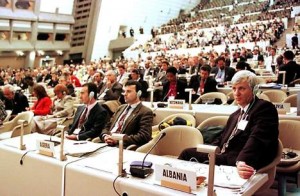The Kyoto Protocol (1997)
 A product of 160 countries meeting in Kyoto, Japan in December 1997
A product of 160 countries meeting in Kyoto, Japan in December 1997
- The goal of the protocol is to reduce the total emissions of industrialized countries to 5.2% below 1990 levels
- Carbon sinks may count toward a country’s commitment to reduce greenhouse gases.
- A “sink” is any process that removes greenhouse gases from the atmosphere (ex: forests)
- Carbon credits and Emissions Reductions Trading: this means that countries that reduce their greenhouse gas emissions by more than is required under Kyoto can sell their unused carbon credits to countries that find it difficult or expensive to reduce emissions.
- Some believe that a country being able to pay others in order to keep polluting is wrong; others say that it is a way of encouraging those who can to make greater reductions while penalizing those who don’t.
- Not every country has formally agreed to (ratified) the Kyoto Protocol
The Copenhagen Accord (2009)
 A document drafted by the United States, Brazil, China, India, and South Africa
A document drafted by the United States, Brazil, China, India, and South Africa
- Recognized by other countries in Copenhagen in December 2009
- Supports continuing the work from the Kyoto Protocol
- Not legally binding
- Recognizes the scientific view that the increase in global temperatures needs to be capped at 2o. Does not set this as a target.
- Recognizes that global greenhouse gas emissions must be cut drastically and as soon as possible
- Suggests that emission cut plans be tied to the global economy
- Highlights the need for aid in developing countries to help them adapt to the effects of climate change
- Supports funding and other incentives for developing countries
- Establishes an international monetary fund. Developed countries set a goal to raise $100 billion by 2020 and locally develop relevant technology.
An assessment of this accord is due by 2015
